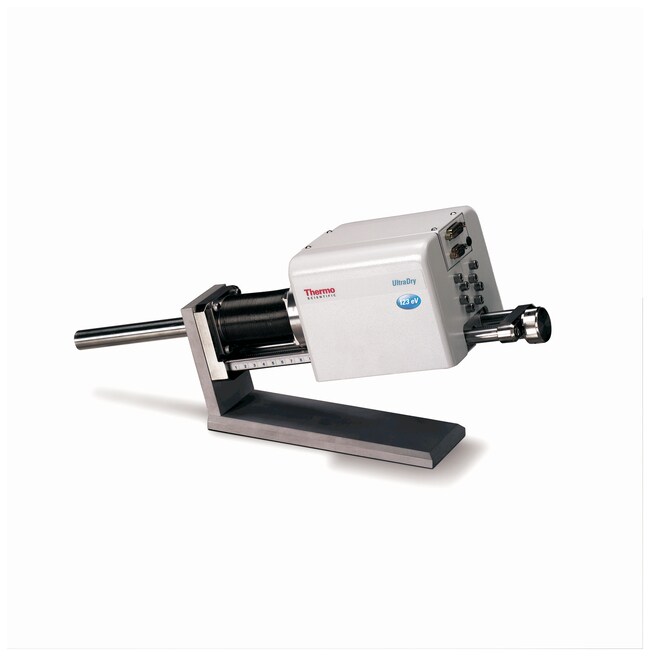Search Thermo Fisher Scientific
Thermo Scientific™
UltraDry EDS Detector
Catalog number: IQLAADGABKFABSMANG

Thermo Scientific™
UltraDry EDS Detector
Catalog number: IQLAADGABKFABSMANG
Develop faster, more accurate interpretation of X-rays for industries such as metals and mining, advanced materials and semiconductors with the Thermo Scientific™ UltraDry EDS Detector, which provides superior resolution at incredibly high collection rates for the Thermo Scientific™ Pathfinder™ X-ray Microanalysis Software.
Catalog Number
IQLAADGABKFABSMANG
Unit Size
Each
Active Area
Up to 100 mm2
Integrated Operation
EDS, WDS, and EBSD operation and analysis in a fully unified software platform
Price (USD)
| Active Area | Up to 100 mm2 |
| Chemical Typing | Chemical Typing software classifies particles by matching their quantitative chemical composition to a database. |
| Description | UltraDry EDS Detector |
| Feature Sizing | Feature Sizing software collects the morphological and chemical characteristics of infrequently occurring particles in large area samples. |
| FWHM Measured | 5.89 keV (Mn-Ka) with 10,000 counts per second |
| Input Counts | >1,000,000 |
| Integrated Operation | EDS, WDS, and EBSD operation and analysis in a fully unified software platform |
| Operating Environment | 35°C |
| Options | Motorized slide |
| Peak Shift | ±5eV peak shift (±3eV typical between 1% and 60% deadtime) from minimum to maximum count rate at a given analyzer time constant |
| Resolution | ±5 eV resolution change (±3eV typical between 1% and 60% deadtime) from minimum to maximum count rate at a given analyzer time constant |
| STD Distance | 50 mm |
| TOA | 35° |
| Unit Size | Each |
Showing 1 of 1
| Catalog Number | Specifications | Unit Size | Active Area | Integrated Operation | Price (USD) | ||||||||||||||||||||||||||||||||||||||||||||||||||||||||||||||||||||||||||||||||||||||||||||||||||||||||||||||||||||||||||
|---|---|---|---|---|---|---|---|---|---|---|---|---|---|---|---|---|---|---|---|---|---|---|---|---|---|---|---|---|---|---|---|---|---|---|---|---|---|---|---|---|---|---|---|---|---|---|---|---|---|---|---|---|---|---|---|---|---|---|---|---|---|---|---|---|---|---|---|---|---|---|---|---|---|---|---|---|---|---|---|---|---|---|---|---|---|---|---|---|---|---|---|---|---|---|---|---|---|---|---|---|---|---|---|---|---|---|---|---|---|---|---|---|---|---|---|---|---|---|---|---|---|---|---|---|---|---|---|
| IQLAADGABKFABSMANG | Each | Up to 100 mm2 | EDS, WDS, and EBSD operation and analysis in a fully unified software platform | Request A Quote | |||||||||||||||||||||||||||||||||||||||||||||||||||||||||||||||||||||||||||||||||||||||||||||||||||||||||||||||||||||||||||
| |||||||||||||||||||||||||||||||||||||||||||||||||||||||||||||||||||||||||||||||||||||||||||||||||||||||||||||||||||||||||||||||
The UltraDry EDS Detector Features:
- Extraordinary operating space to enable superior performance with advanced field-effect transistor (FET) integration and a proprietary preamplifier stage
- A smaller, integrated FET to virtually eliminate electronic noise
- Minimized dead time and maximized resolution to effectively handle pulse pile-up and sum peaks
- Eliminated external or liquid nitrogen cooling with while maintaining extremely high data collection rate
- Consistent data collection rates across the widest range of distances — absolutely critical to dual EDS and EBSD acquisition — with unique slotted collimator design
- One of the greatest solid angle of collection available for detectors on the market today with crystal active area range (10mm2, 30mm2, 60mm2, 100mm2) and small packaging envelope
- FWHM measured (ISO 15632) at 5.89keV (Mn-Kα) with 10,000 counts per second stored in the spectra, measured on the electron microscope
- WD range is measured by varying the vertical distance between the pole piece and the surface of the sample and measuring the input count. STD distance of 50mm. TOA of 35°. The range is defined as within 25% of the peak count rate at the optimized working distance.
- Vertically slotted collimator to enable maximum WD range. Absolute requirement for dual EDS/EBSD acquisition mode.
- Light element sensitivity down to beryllium
- No auxiliary cooling connections, water or fans. No liquid nitrogen.
- Operating environment to 35 °C
- ±5 eV resolution change (±3eV typical between 1% and 60%dead time) from minimum to maximum count rate at a givenanalyzer time constant
- ±5eV peak shift (±3eV typical between 1% and 60% deadtime) from minimum to maximum count rate at a given analyzertime constant
- Input count rates >1,000,000 counts per second
- Motorized slide optionally available
Figures
Documents & Downloads
Certificates
Search by lot number or partial lot number
Frequently asked questions (FAQs)
Citations & References
Search citations by name, author, journal title or abstract text